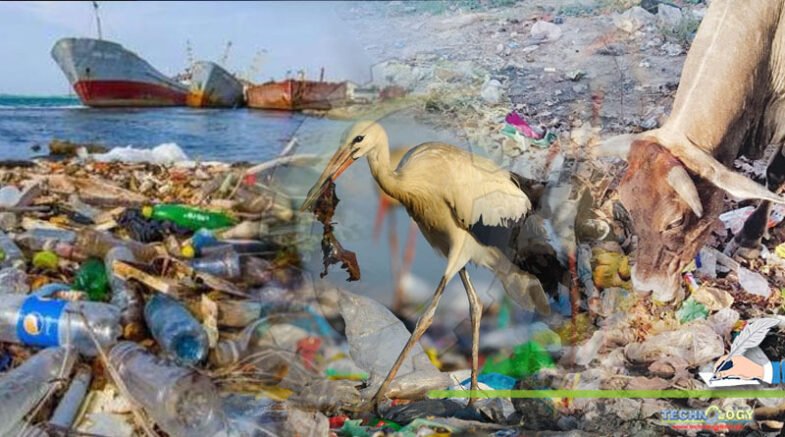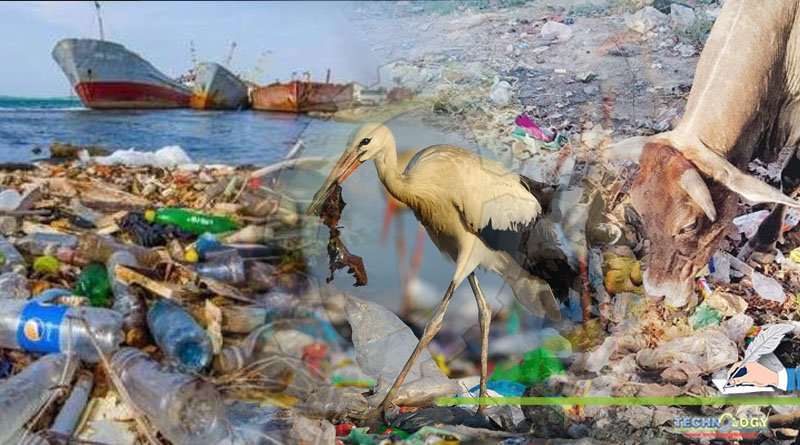Like most government-driven initiatives, the so-called campaign against plastic pollution went into veins. The cosmetic arrangement has brought nothing but worst.

Like most government-driven initiatives, the so-called campaign against plastic pollution went into veins. The cosmetic arrangement has brought nothing but worst. It was like a test case both for federal and provincial administrations to perform what they talk about a lot in the name of the catchy commodity the “Plastic Pollution”.
Although the campaign against plastic pollution was very slow, but the initiative had seen the light of day in Islamabad’s capital, while Sindh has not gone beyond slimy slogans to let this dream come true. Steel nerves and long-term planning are the only tools that may hit where it hurts more, this time the masses.
Plastic today has virtually taken over and become popular. However, Polyethylene, which today is one of the world’s most ubiquitous plastics, had been created in 1898, and then again in 1933.
Plastic, a petroleum bi-product, now is a widely used item around the sphere. Plastic is one out of 12 products produced while crude petroleum is subjected to purification. So, drop or rise in the price of oil directly affects the cost of making new plastic products, including bags and bottles.
Our ancestors passed on to us a worth living biosphere, but so-called industrialization has ruined every blessing, may it be water, air or land to name few.
Plastics are a non-renewable form of energy, and they are disposed of is to burn the product, which leads to air pollution because poisonous chemicals are released into the atmosphere during combustion. Besides, when such smoke is inspired by animals or humans it can affect their general well-being and cause respiratory disorders including lung cancer.
Moreover, plastic posed pollution has caused greater impacts on the environment by adding share into CFC gases, that in turn are a leading cause of depletion in the Ozone layer that is a major cause of Global Warming.
Global industry analysts conclude that global plastic consumption throughout the globe was approximated at 260 million tons in 2008, and it was predicted to be more than 300 tons in 2015, actual figure was 322 million tonnes. In 2021, global plastics production was estimated to be 390.7 million metric tons, with an annual increase of four percent.
These plastics harm in diversified ways. Wildlife and marine creatures at times confuse plastics wastes for food, affecting them when ingested or may be exposed to the toxic chemicals present in the plastics that can cause biological upsets. Instead of green pastures, urban cattle are subjected to eat from garbage.
It is unequivocal truth that large quantities of plastics have been found in the stomachs of many dead animals. When the plastics are ingested, they upset or fill up the digestive systems of the animals, thus contributing to their death due to blockage or starvation.
Besides the multiple campaign against plastic pollution, it is usually seen that the cattle roaming on roads spend hours in the garbage and eating plastic. There are reports of marine animals trapped in plastic waste containing toxic chemicals which can harm the animal’s vital organs, ultimately taking them to the point of no return.
Also, toxic chemicals such as polybrominated diphenyl ether (PBDE), bisphenol A (BPA), and phthalates leaching from the plastics have been associated with medical problems in the endocrine system in general and thyroxin and calcitonin hormones. Disruption in these secretions is known to affect the reproductive performance of women and the metabolism of juveniles.
The most unbearable aspect of plastic is land pollution. Plastic wastes have resulted in the destruction and decline in the quality of the earth’s land surfaces in terms of use, landscape, and ability to support life forms. Mainly, it’s because plastics leach hazardous chemicals on landforms breeding grounds for diseases, and litter available space thereby reducing productive land areas. The bulk of plastics also end up in landfills and since they take years to break down, they heap up causing significant health implications to plants, people, and animals within the surrounding.
Groundwater pollution is still a hidden harm, the least known to the common man. Our municipalities do not have any proper solid waste management plan, hence tons of garbage including plastic is dumped in landfills. Decomposing bacteria and scores of fungus species do their job in decomposition, and the hazardous chemicals present in them seep underground when it rains. During the rainy season, chemicals leached from plastic are mixed with underground water tables, thereby creating underground pollution of very dirty levels.
Visit any water body Kenjhar and Manchhar for instance. Edges of the entire lake are polluted with plastic, affecting a great number of aquatic creatures, including migratory birds that travel miles from the Tundra ecosystem to the warm water lakes of Sindh.
Estimations reveal the existence of billions of tons of plastics in swirling convergences constituting about 40% of the globe’s oceanic surfaces and to sheer surprise, the concentration of the issue increases every day.
Plastic has also found an indirect route to get into the human body. Reports from India of toxins in cow’s milk led to a Supreme Court ruling in January 2014 attempting to make safe the milk supply. The toxins, including dioxins, pass into the milk from plastic ingested by the cows, which in India are often left to fend for themselves and can be found foraging in the rubbish bins.
There are also reports that we are breathing in tiny particles of plastic, and we have no idea what they are doing to us.
These days, everyone is aware of the devastating extent of plastic pollution in landfill and in the seas and oceans; and the damage such plastic is doing to animals that live in and alongside rivers and seas. We have all seen distressing photos of turtles tied up with plastic cane holders, or seabirds who died with stomachs full of plastic, however, I, for one, was not aware of the extent of plastic pollution in the air. Deposits of these tiny microplastic particles are beginning to coat the whole Planet. We are literally creating a Plastic Planet.
Be aware. The speed with which, tiny micro plastic particles are beginning to coat the whole Planet. We are literally creating a Plastic Planet.
Our governments are best at lip services. A small-scale effort will not even be a pebble in the pond. There is a dire need to develop robust and long-term policies to handle this issue. I would suggest developing a Ministry of Plastic Pollution with the responsibility of running a mass awareness campaign against plastic pollution and the use of re-cycle paper packing to reduce if not eliminate it forever. Or otherwise, the mass of plastic detritus present in the oceans is so huge that it is called the “7th continent”. If this continues, by 2050, there will be more plastic than fish in the oceans.
